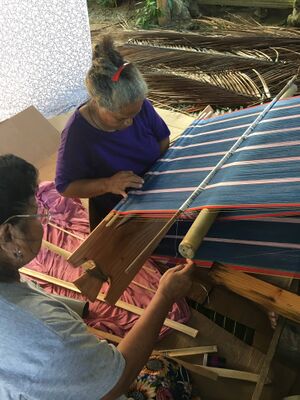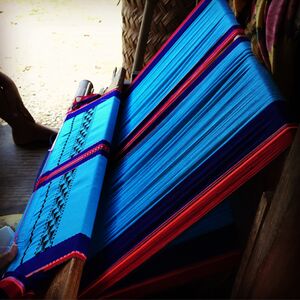Weaving
Beautiful durable loom-woven textiles of Micronesia display an artistry and technical virtuosity unrivaled elsewhere in the Pacific. Chief among them is the lavalava, a loom woven skirt from the Outer Islands of Yap State, situated in the Western Caroline Islands.
Weaving these skirts requires tremendous skill, work and patience. It also requires a special type of backstrap loom.
Contemporary Women's Perspectives
“Some of the young migrants from the islands leave before fully knowing themselves or what it is they seek or want in life. They leave their islands, their culture and roots and go immerse themselves in their new environment and undergo culture shock and much adjustment to acclimate. They work hard and must work to survive in Guam, Hawaii and the US Mainland, and in so doing, they have no time to stop and reflect on where they came from or the culture and skills and ways of things and people of the islands and possibly forgetting weaving skills they may have learned as young girls…it is therefore our hope that this project and the tools and step by step process of getting the materials for a warp and loom and assembling them will help to rekindle the weaving knowledge some left the islands with and or teach it to their daughters and nieces where ever it is they may reside away from the islands and hold tight to their islands roots and foundations so that they may not be lost to us.”
“Weaving is a main chore for the women of the outer islands of Yap. It is rare that a loom is left empty for an extended period of time. With no toys to play with, the little girls play house, so they make little gardens and weave little baskets and make their own little looms from sticks and banana and pandanas fiber (depending on what is left from their mothers, aunts and older sisters).”
“Weaving for outer island girls is just the natural process of growing as it is integral part of their daily lives and chores and it is what they see and learn growing up. Normally an outer island girl would graduate (if she graduates at all) from 8 th grade and is already weaving on a standard sized back strap loom. The girls grow up knowing that at some point in their adolescence they will undergo a ceremony at which they will shed their childhood wear of plain cloth and done the lavalava with all its restrictions and expectations from both their families and community.”
Transmission of Weaving Skills
Skills of weaving are transmitted orally, through observation, and guided practice among the Remathau, the people of the Outer Islands of Yap. This process transmits knowledge from mothers to daughters and aunts to nieces. The specifics are highly tactile and the learning intrinsically experiential. A young woman needs both a mentor as well as the horizontal tension loom (or “back-strap loom”), which consists of a cloth beam, weaving sword, single heddle, shed stick, lease rod, warp beam, and wooden shuttle.
“With the introduction of modern government and various religious groups, the island chiefs are slowly losing their grasp on the traditional ways of governing and uniting their communities. The chiefs word no longer carries the ultimate authority on some islands now, because they say one thing and do another thing and are focused on their personal needs rather than that of the community as a whole, as was the custom and part of the role of the chief. Previously people would pay a courtesy visit to the chief and inform them of their plans to travel to nearby Yap and the purpose of their trip, today people just get up and travel between islands and to and from Yap at will, which has made migrating outside of Yap not only possible but simple (with money for an airplane ticket and a host to provide lodging wherever the destination may be, until they are able to finance their own living with odd jobs or other).”
Significance For Migrants
“Due to many factors, including sea level rise, changing times and minds, seeking better education and joining today’s trend of flocking out of the islands, whether it be out of curiosity of the unknown or in search of ways to work and get cash to support self and family/clan. People of the outer islands of Yap are migrating in larger number to the main island of Yap and beyond as opposed to the 80’s.”
“There are placed-based differences in weaving in the Outer Islands of Yap. These are most evident in the subtle differences among warp boards. The warp board, or warping table, serves as a guide for laying out the warp. It is used to create a continuous, spiral wound, warp. This “tube” or “ring warp” is then mounted onto the loom. The warp board is a flat board with holes to mount warp pegs, each of which correspond with position of back and front beam, coiling rod, heddle rod, shed rod, and lease stick once the warp is mounted on the loom. Specific placement varies amongst the three board patterns.”
The size and weight of these items are such that very few women who move off island for health, education, or employment are able to bring a loom with them. Many migrants are young women, who departure to further their education, at an age by which they may not have completely learned weaving skills. Once in the United States they are often in proximity to other Outer Islanders with expertise but similarly lack looms. It is at this point –when young women who lack weaving skills arrive in the US, or women who can weave but lack access to looms give birth to daughters in the US- that the link in transmission of weaving skills is fatally severed.


